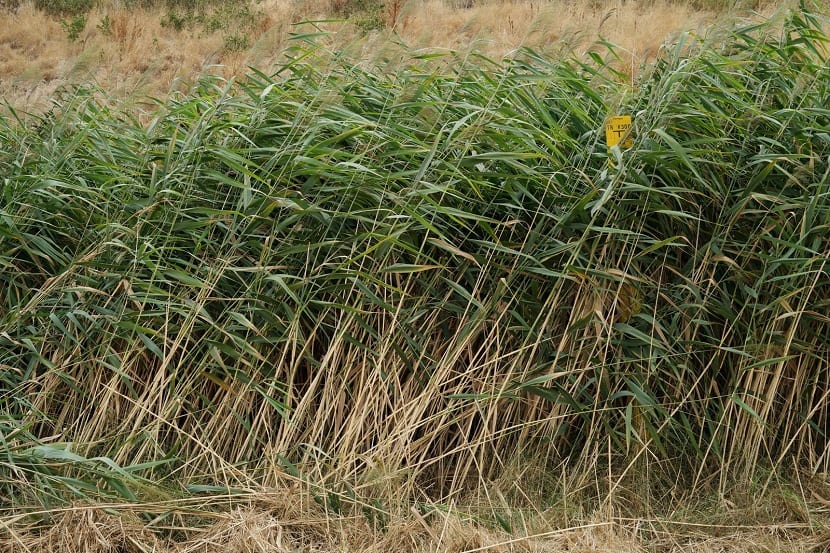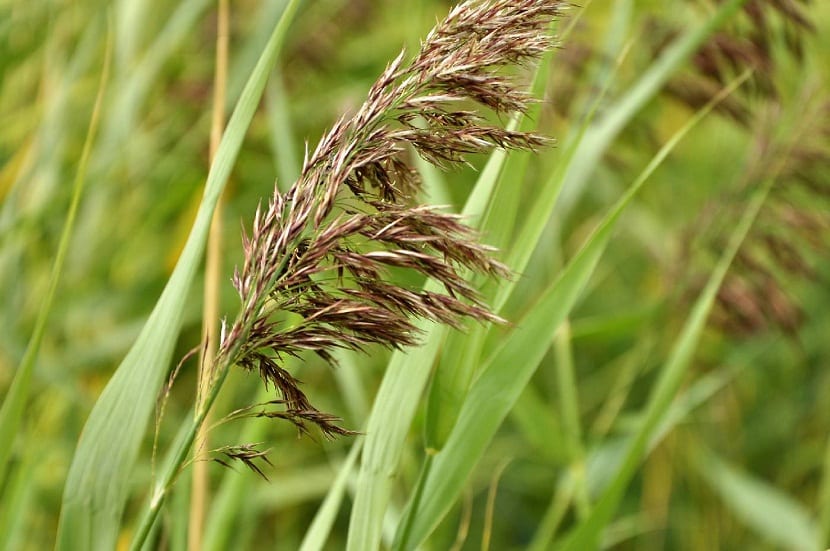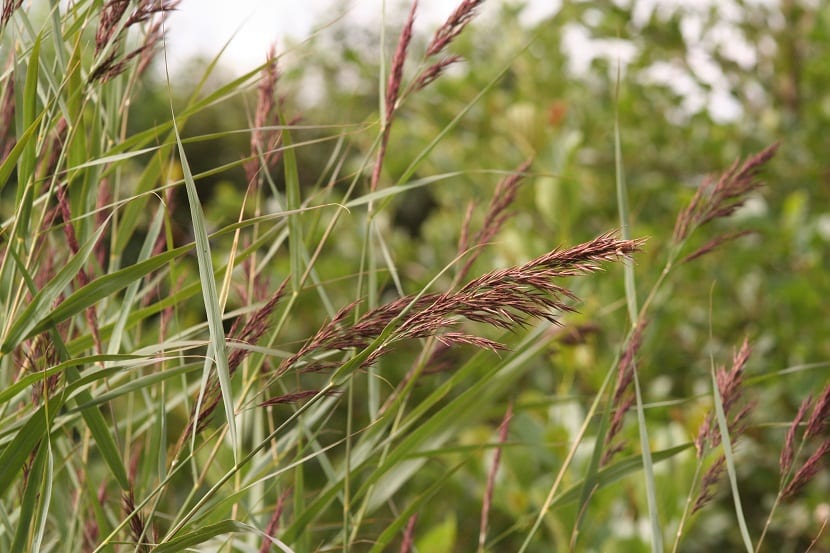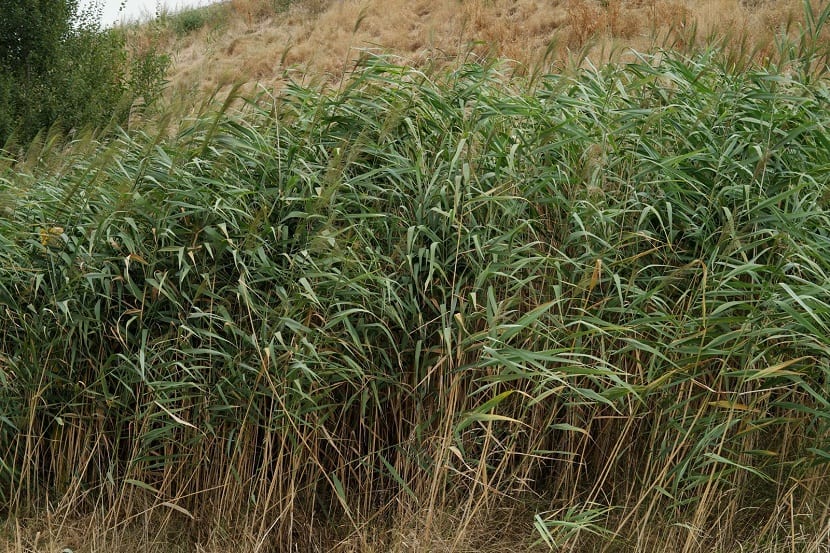
La Phragmites australis is a very common aquatic plant in temperate wetlands and belongs to the family poaceae and its name comes from the Greek sound phrase which means thin reed. This majestic species develops robustly, thanks to its strong rhizomatous root system.
It can reach sizes between 2 and 6 m in height, due to its large robust stems, depending on the type of soil and the humidity prevailing in the environment. Although it prefers humidity, it tolerates temporary droughts very well. It is an invasive plant, which makes it excellent for plant purification.
Features

This type of plants that we can find in places with a lot of humidity it is usually a good indicator that the soil has enough nutrients Punto is a plant that requires a high degree of humidity and a moderate to high temperature. By having high nutrient needs, all the soils where you can find this plant will indicate that they have good quality.
For example, this plant It is distributed within the Southeast Regional Park and it is widely distributed along the four rivers that make up this part. In addition, we can also find them in the 123 lagoons that are cataloged.
La Phragmites australis in suitable conditions it can grow over 4 meters in height. Its stems are robust, vertical, green, persistent and hollow and its alternate leaves are placed on one side of the stem, greyish green color, elongated, flat and narrow and slightly rough edges.
The inflorescence of this plant occurs in the month of August. Its flowers appear as a tuft formed by numerous brownish spikelets.These spikes have multiple branches and are densely flowered. The spikes or panicles can measure up to 20 cm wide after the flowering of the plant. Each spikelet contains from 2 to 12 flowers.
The dimensions of the flowers decrease from the base to the top of the spike. Sometimes not all spikelets are successful, because some of them are reduced to a glume and a floret, which causes the tassels not to show a feathery appearance. In relation to the seeds these are small and can measure 1.5 mm long.
We are talking about a type of perennial plant that it reproduces mainly through the rhizomes. This means that it needs a large area to be able to reproduce and spread throughout the field. One of the main characteristics for which this plant stands out is that, during the summer season, it has a green color and during the winter it turns a reddish-brown color.
These varieties of colors can also depend entirely on the temperatures that are in each season. It is possible that we are already in the autumn and that they still do not have the reddish-brown color that characterizes them during these times of lower temperatures.
Origin and habitat
This is a plant of European origin that is widely spread in the world, it is practically present on all five continents, particularly in temperate regions. It is very widespread in swampy landsIt can also be seen in emerging and persistent wetlands.
Propagation of the Phragmites australis
The species reproduces from seeds and through the stolons and rhizomes. Local multiplication occurs particularly through vegetative growth and regeneration process, the rooting of new populations of Phragmites you get with the spreading the seeds, rhizomes and seedlings.
In swampy lands below sea level, its growth occurs primarily thanks to its strong rhizomes. Regarding the pollination process, it can be said that it is the most common, however, there can be a production of seeds without the need for fertilization.

Uses and function of Phragmites australis
The reed has been used for a long time in the world of basket weaving. Its characteristics have mainly been used to make mattresses, mats and baskets. Sometimes, due to the lack of other types of materials, it has been used as tutors for more tender plants. The leaves and shoots that it has that are more tender are edible and serve as a dye for both green and yellow clothes.
Another use that has been traditionally used is for construction. In this ambit, It was used to make some roofs in huts and sheds. If we use its rhizome and use it as a decoction until it becomes a powder, it can serve as a diuretic,
milk-repellent and diaphoretic.
As for the function that the reed exerts in the ecosystems, it is quite important. And is that It fulfills an essential function since many aquatic birds inhabit and make their nests among these plants.. Since these plants are found in places with a lot of
humidity and in water courses of different sizes and characteristics, birds take advantage of their density to create their nests.
Therefore, the Phragmites australis It has become quite an interesting plant from both an ornamental and environmental point of view. On the one hand, we have its ornamental power since it is considered one of the aquatic plants that are used to decorate
various artificial ponds. Surely you can find these plants in artificial lagoons of some urban parks and surroundings.
On the other hand, we are talking about a plant with great environmental functions so It is used for the restoration of areas
damp. It is a fairly versatile plant and since it can be used in coastal and inland ecosystems for their recovery and stabilization of ecosystems and their flora and fauna.
Caring for him Phragmites australis
As we have mentioned before, this plant not only has a use in the field of environmental restoration but also can be used for ornamental use in gardens and parks. If we want to have it in our garden or sow it in our field we must know the prerequisites it needs.
The first thing is the location. It is clear that if it is a plant that grows in natural riverside ecosystems, it needs an outdoor location and in full sun. It is possible that it can also be developed in semi-shade, although it is not the most indicated. You need a large number of hours of
sun a day.
As to soilWe have already mentioned that it needs a great supply of nutrients. However, this is not conditioning as long as it can have good drainage and remains moist. The drainage allows that it does not end up accumulating too much irrigation water
and a sufficient humid state is maintained so that the plant can develop in good conditions. To maintain this humidity that the plant needs, we will have to water it frequently. It is necessary to water daily and even have the lawn near it
plant to take advantage of the continuous water.
It does not need to be fertilized in any way unless the soil is too poor.
The best time of year to sow it is in spring. This is due to the fact that it is not able to withstand very low temperatures and the continuous frosts can prevent its growth. At most this plant can withstand -7 degrees of temperature
for a very short time. That is, it can only withstand the occasional frost.
Economic impact
La Phragmites Australis As it is a widely invasive plant, it can affect large areas of crops, especially those found in the vicinity of drainage systems or irrigation canals, these are suitable sites for the plant to initiate the invasion relatively easily. There is news from all over the world of numerous crops that have been affected by the plant.
Throughout Europe it is considered one of the most important causes of the appearance of various problems, such as the growth of weeds in canals and water systems, it is a common situation in various regions of the world. In countries like Egypt, it is a significant element of the flora in the canals, where it has also invaded salinized areas of irrigated lands.
The main problem of this type of aquatic weed is the blockage of the water flow, which causes problems related to the operation of the systems, such as the cases of water drainage, water supply for irrigation and access to fishing.
Information has arrived from Kazakhstan indicating that this plant plays an important role in the development of swarms of locust pests. The species can also act as a sort of platform to host a number of important cereal virus diseases, including corn dwarf mosaic virus, barley yellow dwarf virus, and sugarcane mosaic virus.
Different types of control
Preventive control
There are a great variety of controls to prevent extreme spread of the Phragmites AustralisSome are based on burning, use of plastic mulches, cultural, biological, physical control, cutting, dredging. Here are some of the most important ones.
Biologic control
Scientific studies have revealed the existence of more than two hundred species of parasites related to Phragmites, including insects, mites and fungi. But not everything ends there, it is believed that there are dozens of other species also associated with the plant.
Other studies indicate the possibility of controlling the invasion of the plant, using cattle grazing, according to these investigations the method has a high potential for success to eliminate the impact on the populations of Phragmites. This option is based on the fact that cattle can maintain a plant-centered diet for a relatively short period, without affecting your health.
Although it is true that low intensity grazing reduces the population of this plant, unfortunately the same does not happen with the root system of the plant. Even if grazing is done at the wrong time, what can happen is that the presence of the stems increases.
Physical control
When resorting to the use of physical methods, care must be taken or else the appearance of the invasive plant could be encouraged. The use of herbicide in combination with a specific burn can be a very effective technique. Once the recommended herbicide has been applied, the burning should be done the following year during the summer or winter.
Plants should not be burned before flowering, as this could stimulate their growth. Some specialists are of the opinion that burning can only stimulate the growth and strengthening of the rhizome and make the remaining population more vigorous. Burning after herbicide application reduces the permanence of dead stem and foliage biomass, which can stimulate plant germination in the following growing season.
Mechanical control

When using various types of power tools (lawn mowers, brush cutters, manual cut), these can be effective in slowing the spread of established populations, but are unlikely to be successful in eradicating a population if not used in conjunction with herbicide application. Excavation of sediments can also be an effective method of control, but if once done, root fragments remain in the ground, re-establishment of the population can occur.
After applying mechanical control, the area should be thoroughly cleaned and all collected debris disposed of to avoid possible seed spread. When mechanical control is used in combination with herbicide application, the latter should be applied first and when at least two weeks have passed, then mechanical control is used.